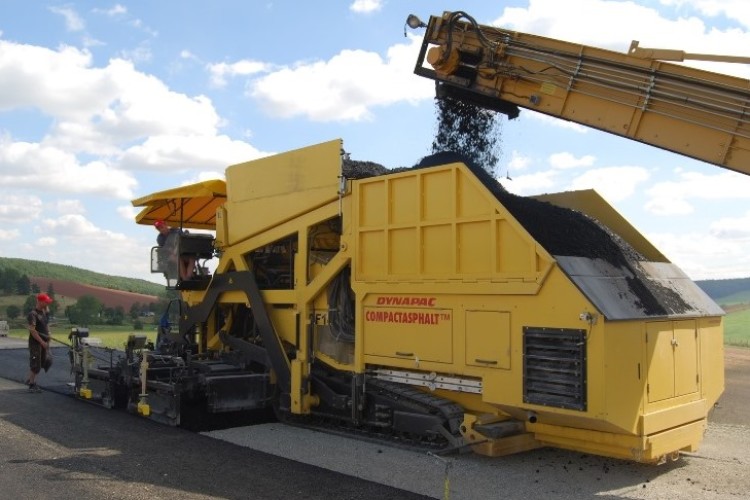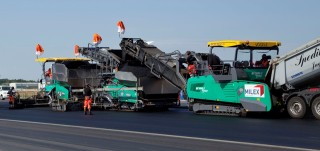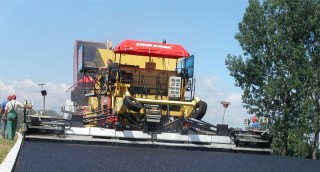Mark Black is a frustrated man. He is the business line manager for road construction equipment at Atlas Copco. His colleagues in Germany have come up with a way of laying asphalt that is quicker, cheaper and better than traditional methods. But Black’s UK customers don’t seem to want to know.
Atlas Copco’s Compactasphalt system has been available for 10 years now and has been used by contractors on dozens of projects in Germany and has started to be trialled in the Netherlands, Sweden, Hungary, Poland, Russia, Canada, the USA and even China, where more than two million square metres of road has been constructed with this method.
The basic concept is that the surface and binder courses are laid in a single operation from the same machine without using a sprayed tack coat of bituminous binders. The heat of the binder course ensures better compaction of the surface course, it is claimed, with no compaction by rolling required for the binder course.
Vögele, another leading manufacturer of road construction machinery, offers a similar system that it calls InLine Pave (pictured below). The binder course and surface course are laid hot-onhot in a single pass by a paving train. Thanks to Vögele’s high compaction technology, developed specifically for this paving technique, no rollers are required to compact the binder course. More than 500,000m2 has been paved hot-on-hot in Germany and the Netherlands, in co-operation with German contractor Matthäi. On all projects, “excellent results” are claimed.
The development of hot-on-hot compact asphalt pavement technology began in Germany back in 1996. It was led by Dynapac (now part of the Atlas Copco group) under the supervision of Dr Elk Richter of the University of Applied Sciences in Erfurt. It took many years of trials to persuade German highway authorities that what worked in a laboratory would work on real roads and would provide a durable road surface.
Any questions about the quality of results obtained seem to have been effectively answered. A study by the University of Darmstadt has confirmed the performance of a 12-year-old Compactasphalt highway in Germany. A group of Lithuanian highway engineers also carried out an in-depth study of the two systems on visits to Germany in 2007 and 2008 for the Baltic Road Association and came away impressed.
Their report states: “By using compact asphalt pavements the following objectives are achieved: better compaction conditions; high bonding and interlocking of two courses, which also guarantees the resistance of surface course to shear stresses and deformations; reduced thickness of surface course saves the high quality and expensive aggregates, which have high polished stone value (PSV) and high retroreflection characteristics.” They also confirm all the benefits claimed by the equipment manufacturers.
Advantages
These are quite impressive and can be summarised as:
Extended paving period: Paving can be carried out in temperatures down to down to 0°C/32°F, which significantly extends the paving season.
Material saving: Half the amount of expensive top course is required and there is no bitumen emulsion (tack) needed between the courses. The required thickness of the surface course of asphalt is reduced from 400mm to 250mm or 150mm. The thinner top layer also allows the cost-effective use of high-value mineral nutrients for polishing resistance, elucidation and edge strength.
Time saving: As two courses are paved in a single pass, it is quicker. In Germany it seems to be precisely twice as quick.
Quality: It also seems that the improved interlocking of the courses results in a more durable surface that is less prone to rutting. All of this implies, of course, not only significant cost savings (life-cycle cost saving of more than €20/m2 in Germany) but also less disruption to road traffic because it is quicker.
UK attitude
So why is the concept meeting with resistance from the UK? The first reason that must be cited is the natural caution and conservatism of the construction industry. “Innovation is a difficult thing because of risk, and everyone is risk averse,” says Dr John Bullas, resident expert on highway construction at consulting engineer Atkins.
.png)
There are other basic factors too. There is not actually a lot of road construction going on so there is not much cash slopping around for investing in new kit.
What road work is going on is mostly just surface repairs rather than two-layer work. Then there is the culture of highway management in the UK. Andy Rowley, commercial director of Tarmac Lafarge Contracting, says that in many mainland European countries it is easier for contractors to close a carriageway. Whether it is Compactasphalt or InLine Pave, hot-on-hot requires big machines with all materials on site and ready to go. Large quantities of mix have to be placed within a short period of time, so site logistics are a critical factor.
Bullas questions whether the UK construction industry is sufficiently well organised to be able to guarantee that essential flow of materials. “To use hot-on-hot would need an infrastructure around it,” he says, “to deliver the continuity of supply of materials.”
The hot-on-hot method is perhaps more suited to the culture of the railways, where contractors might get a weekend or overnight possession of the track, and it’s all hands to the pump throwing everything at the job to get it completed as quickly as possible. On UK highways the motorist is king and must be disrupted as little as possible. We don’t like road closures.
Rowley has looked into hot-on-hot paving. In 2008, when bidding was going on for the 30-year DBFO contract to manage the M25, Tarmac explored every angle for an edge. Tarmac was associated with the Connect Plus consortium that eventually won the contract.
“We were looking at innovative ways for extending pavement life,” he says. “Ingress of water is one of the big issues so laying two layers simultaneously is a good idea. Also, getting more tonnage down in a quicker time appealed to us. So we went to Germany to see the equipment.”
Rowley acknowledges that there is “undoubtedly a strong technical argument” in favour of the method, but not a commercial one – or at least not yet. “I can see the benefits but I can see why it has not taken off,” he says.
Tarmac has recently invested in a Vögele integrated paver that lays the bond coat and surface course simultaneously so that the former permeates into the latter, to give a much stronger bond and also help to prevent water ingress. So it is not afraid of investment or innovation. But the InLine Pave paving train has been, to date at least, something in which he cannot justify investing.
He says he would consider using hot-on-hot for a new construction project with a lot of off-line work, but he is wary of making the required financial commitment to the plant and finding it underutilised. “As commercial director of Tarmac Lafarge Contracting, I would not feel comfortable recommending this bit of equipment.” Instead, he says, he would likely import it on hire to try it out for a contract.
The equipment manufacturers have sought to address concerns about the risk of underutilisation. The Atlas Copco/Dynapac CM2500 Compactasphalt modular system (pictured above, being used in France by Eurovia) places two layers of asphalt in a single pass. Designed to be used with the DF145CS paver, the CM2500 module’s 2.55m-width is designed for applying the Compactasphalt method on roads up to 7.5m wide. It is operated by a single paver crew.
It has an enlarged hopper for up to 28 tonnes of binder material and a 15-tonne hopper for top layer material. There are two augers, which allow the top layer material to be carried under the electrically-heated VB5100TV-E screed. A second screed, Dynapac’s VB805TV Plus-E high compaction screed, compacts the binder layer. Both screeds are synchronized to cope with slope and cross-slope changes.
The CM2500 module is powered by a Deutz TCD2013 engine (116 kW). The drive system is located in front of the paver allowing it to act as a counterweight for optimised balance.
The DF145CS paver can also be used for conventional paving. Attaching and detaching the module takes less than four hours, Atlas Copco says.
Vögele’s InLine Pave system uses two pavers and a material feeder. A modified Super 2100-2 paver places the binder course, a Super 1600-2 or Super 1800-2 paver places the surface course and an MT 1000-1 mobile feeder keeps the pavers supplied with binder and surface course mixes.
A standard AB 500 TV extending screed follows directly behind the train. Vögele says that as the machines are only “marginally modified” for the InLine Pave process, they can also be used for conventional projects at all times.
One application where Atlas Copco’s Mark Black might yet find a taker for the hot-on-hot technique is in airports, where work on the aprons, taxiways and runways is more akin to the railways. The runway has to be closed down but there is a huge commercial imperative in getting it up and running as quickly as possible. “It certainly could be appropriate for that market,” Andy Rowley concedes, with the proviso: “We would need to trial it first to test level control, which is critical in airports.”
Got a story? Email news@theconstructionindex.co.uk






